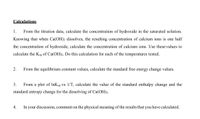
Chemistry
10th Edition
ISBN: 9781305957404
Author: Steven S. Zumdahl, Susan A. Zumdahl, Donald J. DeCoste
Publisher: Cengage Learning
expand_more
expand_more
format_list_bulleted
Concept explainers
Question
No need to solve anything under the calculations. I've provided it so that the, Explanation question could be answered.

Transcribed Image Text:Calculations
1.
From the titration data, calculate the concentration of hydroxide in the saturated solution.
Knowing that when Ca(OH)2 dissolves, the resulting concentration of calcium ions is one half
the concentration of hydroxide, calculate the concentration of calcium ions. Use these values to
calculate the Ksp of Ca(OH)2. Do this calculation for each of the temperatures tested.
2.
From the equilibrium constant values, calculate the standard free energy change values.
3.
From a plot of InKsp Vs 1/T, calculate the value of the standard enthalpy change and the
standard entropy change for the dissolving of Ca(OH)2.
4.
In your discussion, comment on the physical meaning of the results that you have calculated.

Transcribed Image Text:2.
Explain how the following equation will be made use of in the calculations for this
experiment.
AG° = –RTlnK = AH° – TAS°
Expert Solution
This question has been solved!
Explore an expertly crafted, step-by-step solution for a thorough understanding of key concepts.
Step by stepSolved in 4 steps with 4 images

Knowledge Booster
Learn more about
Need a deep-dive on the concept behind this application? Look no further. Learn more about this topic, chemistry and related others by exploring similar questions and additional content below.Similar questions
- Please help me with this one Sugar is the solute and water is the solvent. The drink mix will be considered negligible and is added simply for the visualization of dilution results. Calculate the concentration of sugar in this solution using the volume percent equation. Refer to the background for sample calculations. For the purpose of this exercise, it can be assumed that the weight of the drink mix is 0.00 g. The volume of the solution is 3 and 1/3 cups. Convert to metric units, then calculate and record the volume percent in Data Table 1 (Note that 1 cup = 236 mL). Volume % = Volume of Solute/ Volume of Solution × 100%arrow_forwardAnswer the question by placing the terms in the answer box with a comma an a space in between terms when necessary, (ex. one, two). changes, energy is absorbed by a system. Inarrow_forwardThe mass in milligrams of oxygen (molar mass= 16 g/mol) in 1920 cm³ of 1.76X10-3 M solution of 3 H2Cr2O7 is: Please fill in the space with a numerical value with two digits, without any unitarrow_forward
- A chemist needs 19.89 mL of 1.36 M NaOH. What volume in mL of 3.29 M NaOH must be diluted in water to form this solution? lease report your answer in mL to 2 decimal points with no units.arrow_forwards.) Br DMF(aq)arrow_forwardWhen calcium oxalate monohydrate is heated, anhydrous calcium oxalate and water are formed. Further decomposition of the calcium oxalate produces calcium carbonate and carbon monoxide. If the heating temperature is increased to well above 600 degrees celsius, calcium carbonate will decompose to calcium oxide and carbon dioxide. Write three reactions to depict the decomposition processess described here.arrow_forward
- I don't know how to calculate parts a, b &c of question 9.arrow_forward1 of 4 Find the best match between the following terms with its correct definition phase homogeneous sample heterogeneous sample insoluble miscible immiscible : have two (2) or more phases. : a substance whose particles essentially do not intermingle appreciably with the particles of a second substance. : a liquid substance whose particles are able to mingle with those of another liquid substance. : •Distinguishable portions of a sample. :: a liquid substance whose particles are unable to mingle appreciably with those of another liquid substance. :: have only one (1) phase 1 4 Next»arrow_forwardCalculate the mass of each sample. Part A 17.6 mol HNO3 Express your answer with the appropriate units. HẢ m(HNO3) = Value Units Submit Request Answer Part B 1.88 x10-3 mol H2S Express your answer with the appropriate units. HA m(H2S) = Value Units Submit Request Answer P Type here to searcharrow_forward
arrow_back_ios
arrow_forward_ios
Recommended textbooks for you
 ChemistryChemistryISBN:9781305957404Author:Steven S. Zumdahl, Susan A. Zumdahl, Donald J. DeCostePublisher:Cengage Learning
ChemistryChemistryISBN:9781305957404Author:Steven S. Zumdahl, Susan A. Zumdahl, Donald J. DeCostePublisher:Cengage Learning ChemistryChemistryISBN:9781259911156Author:Raymond Chang Dr., Jason Overby ProfessorPublisher:McGraw-Hill Education
ChemistryChemistryISBN:9781259911156Author:Raymond Chang Dr., Jason Overby ProfessorPublisher:McGraw-Hill Education Principles of Instrumental AnalysisChemistryISBN:9781305577213Author:Douglas A. Skoog, F. James Holler, Stanley R. CrouchPublisher:Cengage Learning
Principles of Instrumental AnalysisChemistryISBN:9781305577213Author:Douglas A. Skoog, F. James Holler, Stanley R. CrouchPublisher:Cengage Learning Organic ChemistryChemistryISBN:9780078021558Author:Janice Gorzynski Smith Dr.Publisher:McGraw-Hill Education
Organic ChemistryChemistryISBN:9780078021558Author:Janice Gorzynski Smith Dr.Publisher:McGraw-Hill Education Chemistry: Principles and ReactionsChemistryISBN:9781305079373Author:William L. Masterton, Cecile N. HurleyPublisher:Cengage Learning
Chemistry: Principles and ReactionsChemistryISBN:9781305079373Author:William L. Masterton, Cecile N. HurleyPublisher:Cengage Learning Elementary Principles of Chemical Processes, Bind...ChemistryISBN:9781118431221Author:Richard M. Felder, Ronald W. Rousseau, Lisa G. BullardPublisher:WILEY
Elementary Principles of Chemical Processes, Bind...ChemistryISBN:9781118431221Author:Richard M. Felder, Ronald W. Rousseau, Lisa G. BullardPublisher:WILEY

Chemistry
Chemistry
ISBN:9781305957404
Author:Steven S. Zumdahl, Susan A. Zumdahl, Donald J. DeCoste
Publisher:Cengage Learning

Chemistry
Chemistry
ISBN:9781259911156
Author:Raymond Chang Dr., Jason Overby Professor
Publisher:McGraw-Hill Education

Principles of Instrumental Analysis
Chemistry
ISBN:9781305577213
Author:Douglas A. Skoog, F. James Holler, Stanley R. Crouch
Publisher:Cengage Learning

Organic Chemistry
Chemistry
ISBN:9780078021558
Author:Janice Gorzynski Smith Dr.
Publisher:McGraw-Hill Education

Chemistry: Principles and Reactions
Chemistry
ISBN:9781305079373
Author:William L. Masterton, Cecile N. Hurley
Publisher:Cengage Learning

Elementary Principles of Chemical Processes, Bind...
Chemistry
ISBN:9781118431221
Author:Richard M. Felder, Ronald W. Rousseau, Lisa G. Bullard
Publisher:WILEY